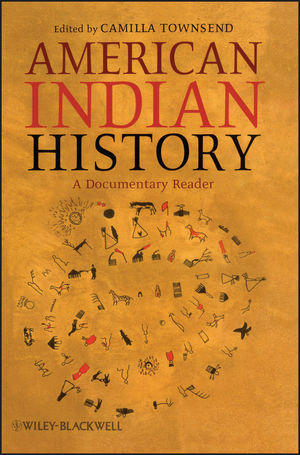|
Textbook
American Indian History: A Documentary ReaderISBN: 978-1-4051-5908-1
Paperback
262 pages
April 2009, ©2009, Wiley-Blackwell
 This is a Print-on-Demand title. It will be printed specifically to fill your order. Please allow an additional 10-15 days delivery time. The book is not returnable.
|
||||||
Series Editors’ Preface viii
Acknowledgments x
Introduction 1
Chapter 1 Indian Ways 9
1 Maya Glyphs at Piedras Negras 9
2 Ancient Nahuatl Prayers from the Florentine Codex 12
3 Pueblo Bonito of Chaco Canyon 14
4 Images of Secotan 17
5 Two Versions of the Haudenosaunee (Iroquois) Creation Story 21
Chapter 2 First Contact 27
1 Arrival of the Spaniards in the Annals of Tlatelolco 27
2 Response to the Spanish by Native Priests 29
3 Don Luis Travels the World 31
4 The Arrival of the Dutch at Manhattan in Native Memory 33
Chapter 3 The Expectations of the Strangers 39
1 Christopher Columbus’s Journal 39
2 Cabeza de Vaca’s Experiences in North America 41
3 Thomas Harriot’s Observations at Roanoke 43
4 John Smith’s Visit to Werowocomoco 44
5 Edward Waterhouse’s Report on the Events of 1622 46
Chapter 4 The Long Struggle for American Lands 50
1 A Jesuit’s Story of the 1639 Smallpox Epidemic 50
2 Gandeaktena’s Decision to Become a Christian 52
3 Metacom’s Grievances 55
4 Mary Rowlandson’s Narrative 57
5 The Declaration of a Rebellious Christian Indian in the Pueblo Revolt 61
Chapter 5 Eighteenth-Century Power Shifts 64
1 The Refusal of Some English Prisoners to Return to English Life 64
2 The Abenakis’ Forceful Statement to the English 68
3 The Chickasaws’ Political Vision in 1723 72
4 Sir Jeffery Amherst Suggests the Smallpox 76
5 The Chickasaws after the Revolution 81
6 George Washington’s Indian Policy 84
Chapter 6 What the New Nation Portended for Indians 89
1 Lewis and Clark in the Pacific Northwest 89
2 Russian Settlements in Alaska 91
3 Tecumseh’s Demands 94
4 The Cherokee Syllabary and Newspaper 99
5 The Cherokee Debate in Washington 102
6 Black Hawk’s Autobiography 112
7 William Apess’s Condemnation of White America 118
Chapter 7 The Losing of the West 122
1 Charles Ohiyesa Eastman’s Childhood Memories 122
2 Lone Dog’s Winter Count, 1800–1870 125
3 Sarah Winnemucca’s Choices 135
4 The Views of George Armstrong Custer 136
5 Black Elk’s Memories of the Battle of the Little Big Horn 138
6 Elaine Goodale’s Observations of the Ghost Dance 142
7 Charles Ohiyesa Eastman’s Visit to Wounded Knee 144
8 Geronimo’s Story of His Life 146
Chapter 8 Surviving Assimilation and the National Imagination 154
1 The 1887 Statement of the Commissioner of Indian Affairs 154
2 Francis La Flesche’s Memories of Boarding School 157
3 A Navajo Girl’s Letters Home from Boarding School 161
4 William Stoddard’s The Talking Leaves 164
5 The Arguments of The Quarterly Journal 166
Chapter 9 Mid-Twentieth-Century Changes 171
1 The Arts and Crafts Act of 1935 171
2 The Navajo Contribution to the War Effort 175
3 The Musings of an Iroquois High Steel Man 177
4 The Menominee Struggle against Termination 181
Chapter 10 The Upheavals of the 1960s and 1970s 184
1 The 1961 Declaration of Indian Purpose 184
2 The Alcatraz Proclamation 186
3 Vine Deloria’s Custer Died for Your Sins 189
4 The Thoughts of Mary Crow Dog 192
5 A Reporter’s Comments on the Deaths at Pine Ridge 195
Chapter 11 The End of the Twentieth Century: A New Era? 198
1 The Origins of the Native American Graves Protection and Repatriation Act (NAGPRA) 198
2 Growing Pan-Indian Activism and the Native Press 201
3 Louise Erdrich’s ‘‘Dear John Wayne’’ 205
4 President Clinton’s 1994 Conference with Native Leaders 207
5 Struggles over the Indian Gaming Regulatory Act 211
6 An Elder’s Stories for Future Generations 216
7 List of Federally Recognized Tribes Today 219
Selected Bibliography 233
Index 240



